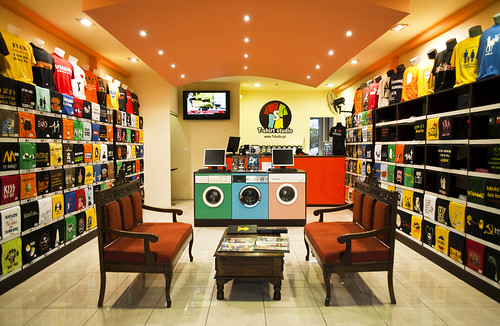
WELCOME TO
INSIGHTS: A DISCUSSION ABOUT “PUBLIC SPACE” DESIGN
Gaddis Architect specializes in all phases of commercial and commercial retail design, design management and construction. If maximizing the success of your business by optimizing the performance of your store, or commercial space design is a goal, then attending the following “Insights” could provide some very real benefits. Many common, and some not so common, design challenges are analyzed. Solutions aimed at increasing retail traffic, creating visual presence in various environments, and expressing not only a particular shopping experience but also the business’s brand, are presented. We think that all design is, on some level at least, retail design. Please scroll on, start a dialogue, contact us anytime.
Storefront donatated as gallery space?

Blossoming Backdrop
I am always surprised when companies with large store planning and marketing resources, not to mention budgets, create and then miss visual display opportunities. It is hardly necessary to comment on the problem here. Any student of this blog can see that the white cut work backdrop forms a high contrast and visually compelling pattern against the black storefront surround and dark interior. It had my attention from across the mall, leading me closer, to be captivated by the interesting pattern. I actually found my self trying to see, snow flakes, flowers, even lace.
So the real question is what did I not see. Of course the main event absolutely disappears. The fix here is too easy to be missed. Just imagine what a great display this would have been had the mannequin been dressed in bold color blocked garments. I almost went in the store to see if they had a suggestion box. Also, on a more serious business note, this is some very expensive real estate. To expensive to be donated as a public service gallery when it should be selling a product.
I see and additional flaw in this display, which may be personal preference and pales in comparison to the aforementioned larger issue, but is, nevertheless, worth a mention here. I have a problem with headless mannequins in storefront displays. I find them unnatural and too cheap for all but limited use.
Visual opportunity created, then missed.
These storefront designs fight the exterior “visual noise,” which would actually be a lot worse had these photos been taken at noon instead of early evening, by framing their storefronts with bright non-reflective graphics in patterns compatible with their particular brands. Judging by the photos it is an effective solution. The shops clearly stand out of the view as a result. Where they fall apart is about how they have merchandised, or in this case not merchandised, the window once they have the attention of the passerby. It looks like they have created an opportunity and then missed it. They send me searching through my stacks for a picture to be Photoshopped into the window so that I can see the full effect had the job been completed.
Can more $ be charged for the merchandise because the ceiling looks expensive? Maybe!

Elevation/Section Through a Curved Ceiling
If you have the budget a curved ceiling can add sophistication, and polish to a rectangular retail department or room. When used in a small space, perhaps 1000 square feet, the ceiling can be held back from the wall allowing for a cove and creating all manner of design possibilities. The cove frames the room and adds focus to the walls, and the curve, if the ceiling is white or reflective, offers a more subtle option by placing indirect light on merchandise displayed in the center of the room.

Detail of Lighting Hidden in Cove
I worked on the boutique in the drawings above. Capturing the light while hiding the fixtures was a big priority. Not only is the cove perfect for this, but it also has a directional quality which points to the merchandise along the adjacent walls.
The best way to know that this T-shirt shop got it right is to imagine what it would look like without the curved ceiling. One quickly realizes that by softening the environment with warm indirect light reflected off of the colored ceiling, the design is performing as noted above and more. Hard to believe the place is selling tea shirts. They can probably charge more just because the ceiling looks expensive.



